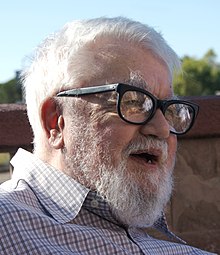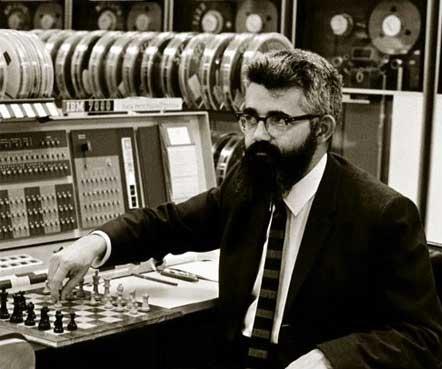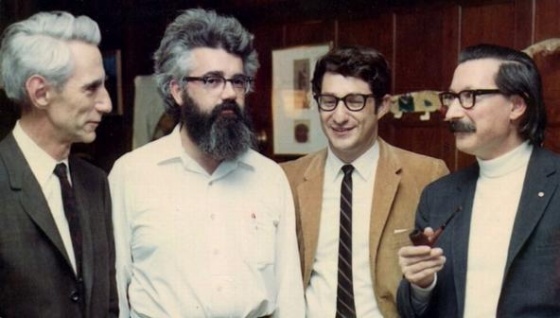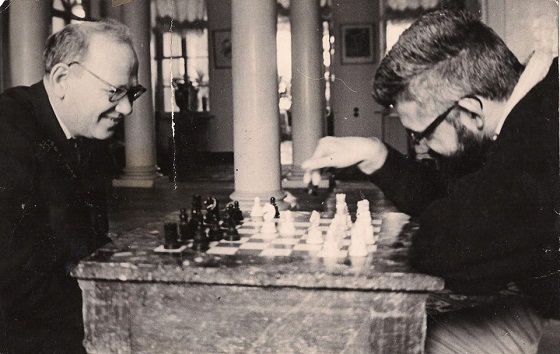John McCarthy

John McCarthy, (September 4, 1927 - October 23, 2011 [2])
was an American researcher in computer science and pioneer in the field of artificial intelligence. After short-term appointments at Princeton, Stanford, Dartmouth, and MIT, John McCarthy became a full professor at Stanford in 1962, where he remained until his retirement at the end of 2000. In 1955, McCarthy co-organized the Dartmouth Conference [3], where he coined the term Artificial intelligence, and introduced the idea of the Alpha-beta algorithm, to become their eponym. Alpha-beta was also approximated by Herbert Simon with Allen Newell and Arthur Samuel and was released to the public by Daniel Edwards and Timothy Hart in 1961 [4] and independently by Alexander Brudno in 1963 [5] . In 1958 at MIT, John McCarthy created the Lisp programming language [6].
Contents
Photos
John McCarthy, playing chess at Stanford's IBM 7090, 1967 [7] [8] [9]
Claude Shannon, John McCarthy, Ed Fredkin and Joseph Weizenbaum (1966) [10]
Georgy Adelson-Velsky and John McCarthy playing chess, Soviet-American computer science conference, Urgench, 1979 [11]
Kotok-McCarthy
See main article Kotok-McCarthy-Program
Between 1959 and 1962, students of John McCarthy at Massachusetts Institute of Technology, Alan Kotok, Elwyn Berlekamp (1960), Michael A. Lieberman, Charles Niessen and Robert A. Wagner, wrote a chess program for the IBM 7090. When McCarthy left MIT to take charge of the Arificial Intelligence Laboratory at Stanford, he took Kotok's program with him and improved it's searching. In 1965, McCarthy visited the Soviet Union and was challenged by Alexander Kronrod for a computer chess match. At the end of 1966 the four game match began between the Kotok-McCarthy-Program, running on a IBM 7090 computer, and a program developed at the Institute of Theoretical and Experimental Physics (ITEP) in Moscow which used a Soviet M-20 computer. The match played over nine months was won 3-1 by the The ITEP program.
Quotes
Alpha-Beta
Quote by John McCarthy from Human-Level AI is harder than it seemed in 1955 on the Dartmouth workshop:
Chess programs catch some of the human chess playing abilities but rely on the limited effective branching of the chess move tree. The ideas that work for chess are inadequate for go. Alpha-beta pruning characterizes human play, but it wasn't noticed by early chess programmers - Turing, Shannon, Pasta and Ulam, and Bernstein. We humans are not very good at identifying the heuristics we ourselves use. Approximations to alpha-beta used by Samuel, Newell and Simon, McCarthy. Proved equivalent to minimax by Hart and Levin, independently by Brudno. Knuth gives details.
What is AI?
Quote by John McCarthy from What is Artificial Intelligence? [12] [13]:
Alexander Kronrod, a Russian AI researcher, said 'Chess is the Drosophila of AI.' He was making an analogy with geneticists' use of that fruit fly to study inheritance. Playing chess requires certain intellectual mechanisms and not others. Chess programs now play at grandmaster level, but they do it with limited intellectual mechanisms compared to those used by a human chess player, substituting large amounts of computation for understanding. Once we understand these mechanisms better, we can build human-level chess programs that do far less computation than do present programs. Unfortunately, the competitive and commercial aspects of making computers play chess have taken precedence over using chess as a scientific domain. It is as if the geneticists after 1910 had organized fruit fly races and concentrated their efforts on breeding fruit flies that could win these races.
Selected Publications
1955 ...
- John McCarthy, Marvin Minsky, Nathaniel Rochester, Claude Shannon (1955). A Proposal for the Dartmouth Summer Research Project on Artificial Intelligence.
- Claude Shannon, John McCarthy (eds.) (1956). Automata Studies. Annals of Mathematics Studies, No. 34, Google books
- John McCarthy (1958). An Algebraic Language for the Manipulation of Symbolic Expressions. Memo No. 1, Artificial Intelligence Project, RLE and MIT Computation Center, pdf hosted by The Computer History Museum, Courtesy of Tom Knight [14]
- John McCarthy (1958). A Revised Version of "MAPLIST". Memo 2, Symbol Manipulating Language, Artificial Intelligence Project, RLE and MIT Computation Center
- John McCarthy (1958). Symbol Manipulating Language - Revisions of the Language. Memo 3, Artificial Intelligence Project, RLE and MIT Computation Center, pdf hosted by The Computer History Museum, Courtesy of Tom Knight
- John McCarthy (1958). Symbol Manipulating Language - Revisions of the Language. Memo 4, Artificial Intelligence Project, RLE and MIT Computation Center, pdf hosted by The Computer History Museum, Courtesy of Tom Knight
- John McCarthy (1959). Programs with Common Sense. pdf
1960 ...
- John McCarthy (1960). Recursive Functions of Symbolic Expressions and Their Computation by Machine, Part I. pdf, the original paper on Lisp
- John McCarthy, Paul W. Abrahams, Daniel J. Edwards, Timothy P. Hart, Michael I. Levin (1962) LISP 1.5 Programmer's Manual. MIT Press, second edition (1985) pdf [15]
- John McCarthy, James Painter (1967). Correctness of a Compiler for Arithmetic Expressions. pdf
- John McCarthy (1979). History of Lisp. Artificial Intelligence Laboratory, Stanford University
1980 ...
- John McCarthy (1989). The Fruitfly on the Fly. ICCA Journal, Vol. 12, No. 4
- John McCarthy (1990). Chess as the Drosophila of AI. Computers, Chess, and Cognition
- Gio Wiederhold, John McCarthy, Edward Feigenbaum (1990). Memorial Resolution: Arthur L. Samuel (1901 - 1990). AI Magazine, Vol. 11, No. 3
- John McCarthy, Edward Feigenbaum (1991). In Memoriam. Arthur L. Samuel: Pioneer in Machine Learning. ICCA Journal, Vol. 14, No. 1 » Arthur Samuel
- John McCarthy (1996). The Mutilated Checkerboard in Set Theory. available as 2001 pdf reprint
- John McCarthy (1997). AI as Sport. Science, Vol. 276, June 6, pp. 1518-1519
- John McCarthy (1997). Chess as the Drosophila of AI. Computer Science Department, Stanford University, condensed version of the 1990 paper, pdf
2000 ...
- Pamela McCorduck (2004). Machines Who Think: A Personal Inquiry into the History and Prospects of Artificial Intelligence. A. K. Peters (25th anniversary edition)
- Johan van Benthem (2011). John McCarthy (1927-2011). ICGA Journal, Vol. 34, No. 4
See also
- Artificial Intelligence
- History of Computer Chess
- History of Alpha-Beta
- Kotok-McCarthy-Program
- Stanford-ITEP Match
- The History of Computer Chess - an AI Perspective - Video
- The Levy Bet
Postings
- In memoriam of John McCarthy by Mel Cooper, CCC, October 26, 2011
External Links
- John McCarthy from Wikipedia
- Professor John McCarthy
- The Mathematics Genealogy Project - John McCarthy
- John McCarthy - A.M. Turing Award Winner
- Father of Lisp and AI John McCarthy has died • The Register by Iain Thomson , October 24, 2011
- John McCarthy obituary by Jack Schofield, guardian.co.uk, October 25, 2011
- Stanford's John McCarthy, seminal figure of artificial intelligence, dies at 84 by Andrew Myers, October 25, 2011
- Breaking News for 2011 - "Obituary: Emeritus Professor John McCarthy of Stanford University (1927 - -2011)" by L. Stephen Coles
- John McCarthy (1927-2011): Artificial Intelligence - Thinking Allowed by Jeffrey Mishlove (1989), YouTube Video
References
- ↑ John McCarthy, 2006, Wikimedia Commons
- ↑ Father of Lisp and AI John McCarthy has died • The Register by Iain Thomson, October 24, 2011
- ↑ John McCarthy, Marvin Minsky, Nathaniel Rochester, Claude Shannon (1955). A Proposal for the Dartmouth Summer Research Project on Artificial Intelligence.
- ↑ Daniel Edwards, Timothy Hart (1961). The Alpha-Beta Heuristic. AIM-030, DSpace at MIT
- ↑ Alexander Brudno (1963). Bounds and valuations for shortening the search of estimates. Problemy Kibernetiki (10) 141–150 and Problems of Cybernetics (10) 225–241
- ↑ The Lisp programming language from Wikipedia
- ↑ John McCarthy, artificial intelligence pioneer, playing chess at Stanford's IBM 7090 | Mastering the Game | The Computer History Museum 1967 ca., Courtesy Stanford University, John McCarthy used an improved version of the Kotok program to play correspondence chess against a Soviet program developed at the Moscow Institute of Theoretical and Experimental Physics (ITEP) by George Adelson-Velsky and others. In 1967, a four-game match played over nine months was won 3-1 by the Soviet program.
- ↑ CSD founding faculty from Computer History Exhibits Photo Tour created January 2000 by Gio Wiederhold
- ↑ See also image from Breaking News for 2011 - "Obituary: Emeritus Professor John McCarthy of Stanford University (1927 - -2011)" by L. Stephen Coles
- ↑ Weizenbaum. Rebel at Work. A documentary by Peter Haas and Silvia Holzinger
- ↑ Photos of Georgy M Adelson-Velsky (1922 - 2014) - ForeverMissed.com, shared by: Семен Карпенко, June 01, 2014
- ↑ John McCarthy (1989). The Fruitfly on the Fly. ICCA Journal, Vol. 12, No. 4
- ↑ John McCarthy (1990). Chess as the Drosophila of AI. Computers, Chess, and Cognition, pp. 227-237
- ↑ LISP 1.5 family — Software Preservation Group from The Computer History Museum
- ↑ McCarthy et al. LISP 1.5 Programmer's Manual from The Computer History Museum Software Preservation Group


